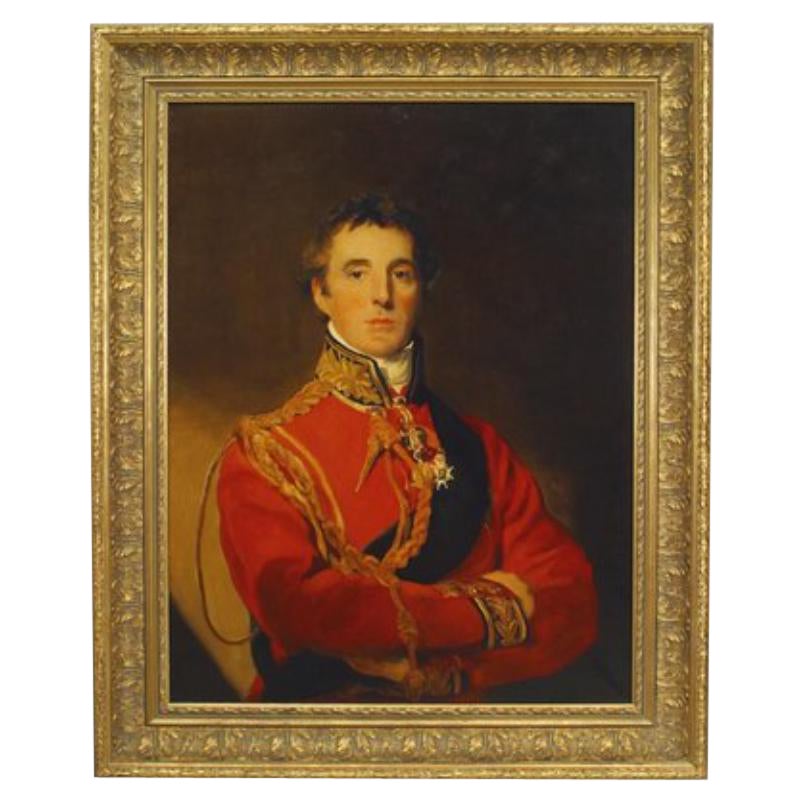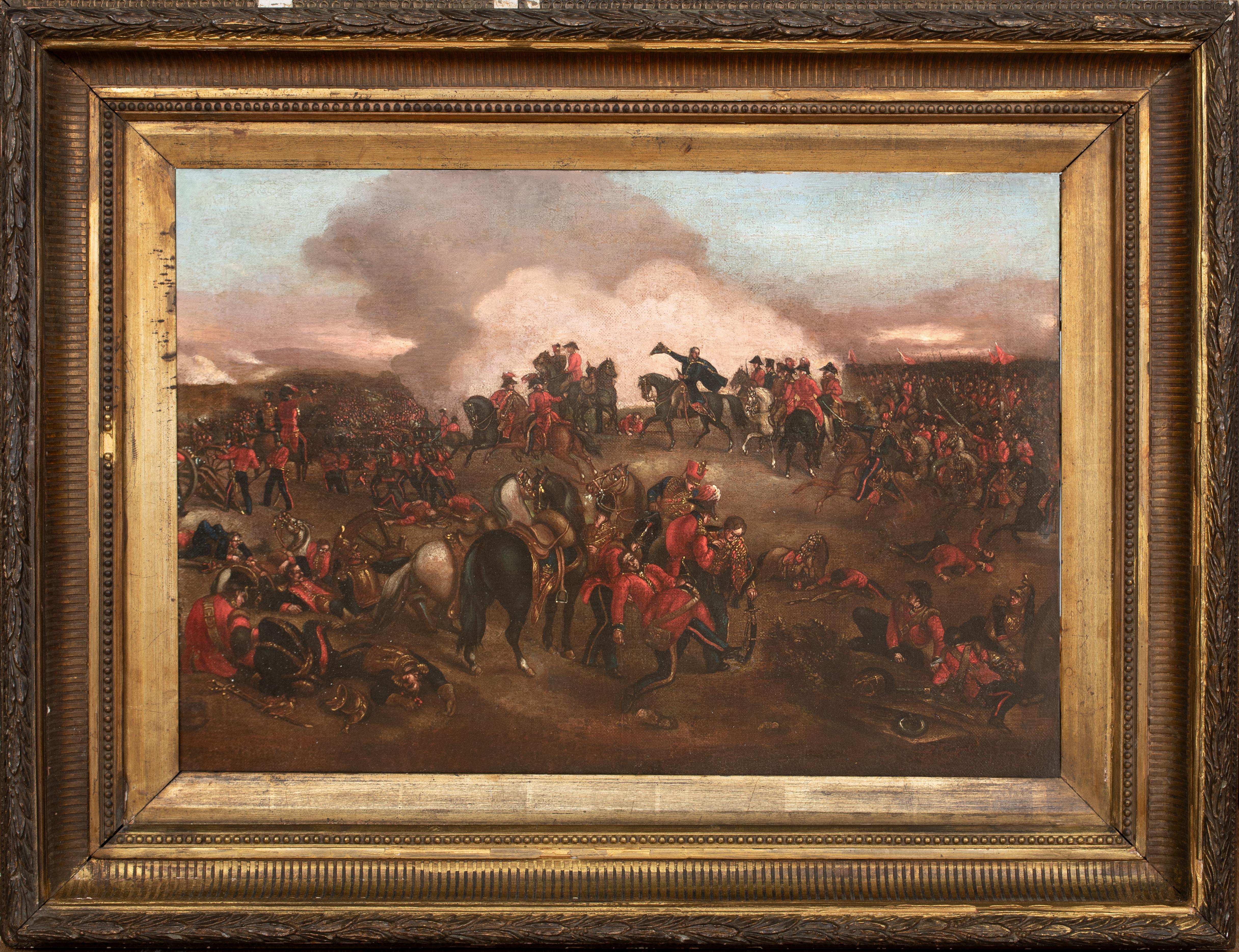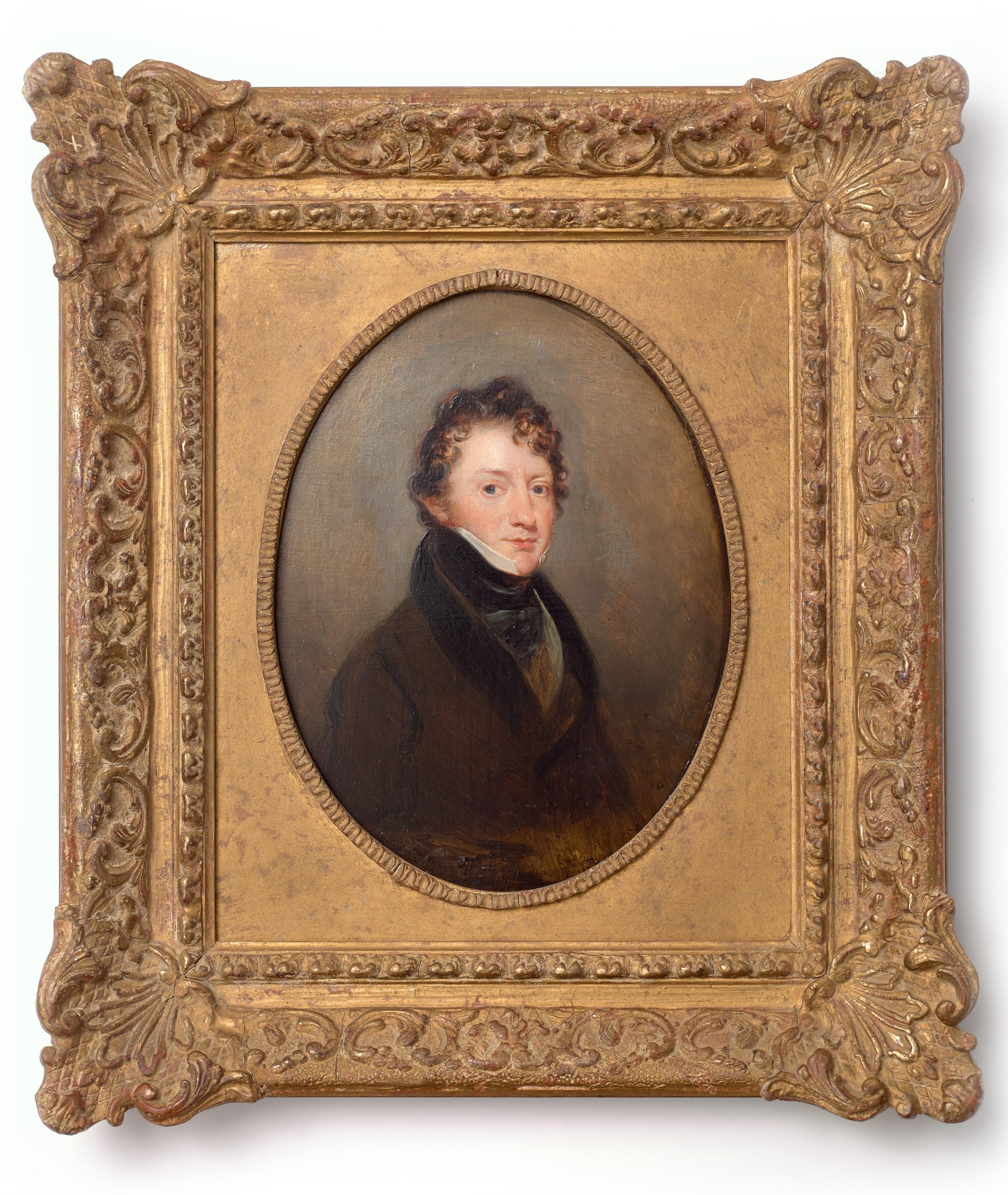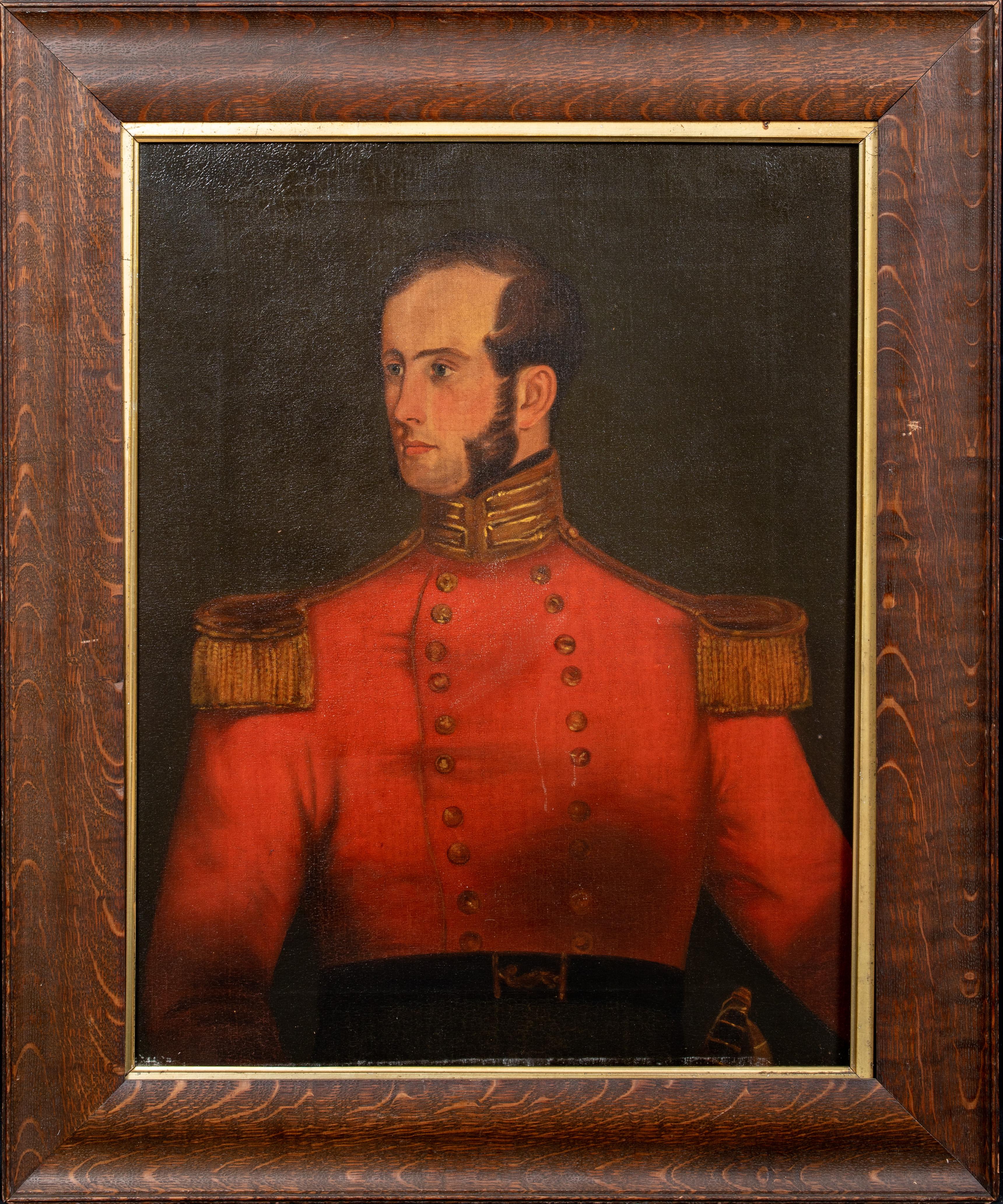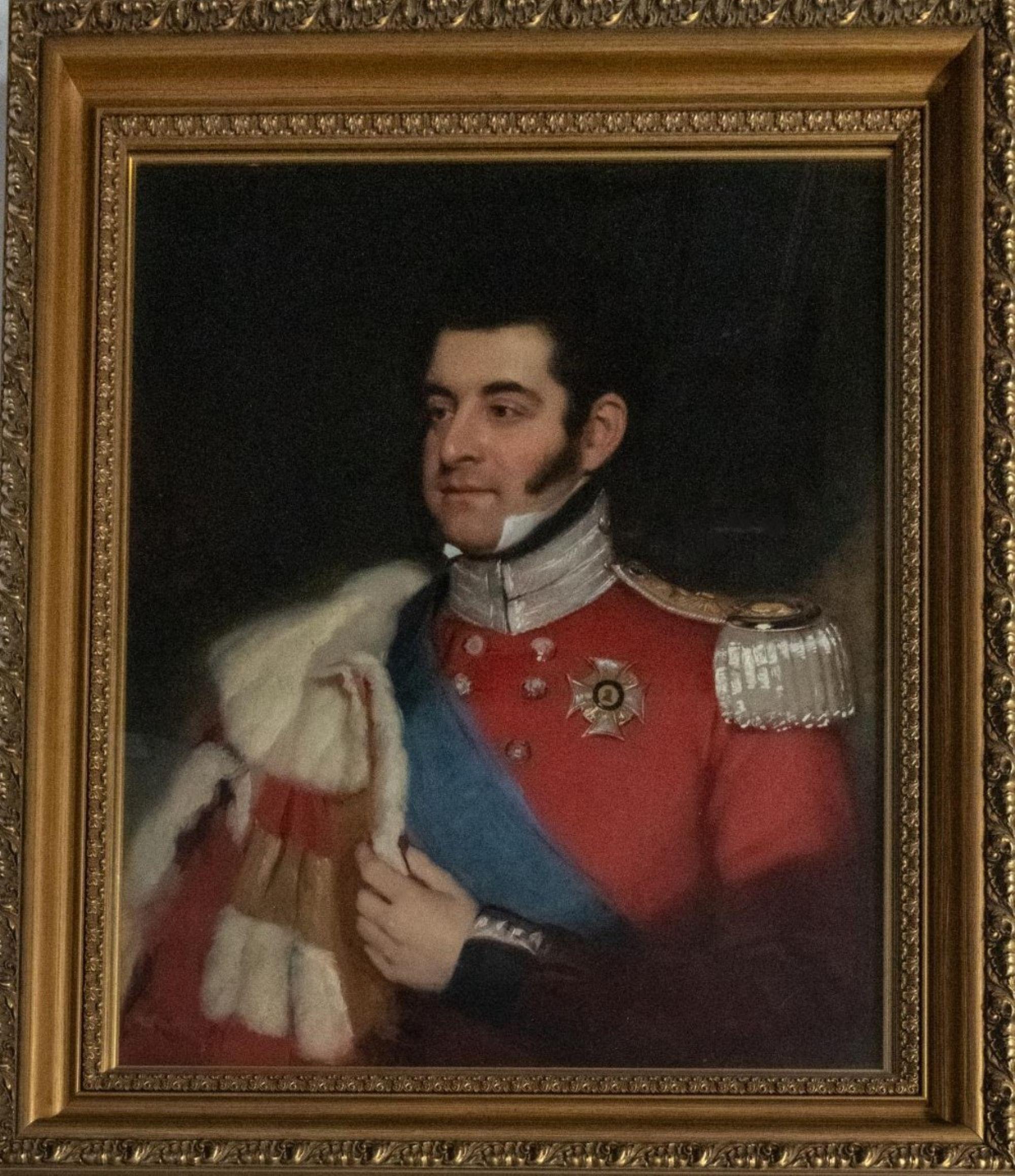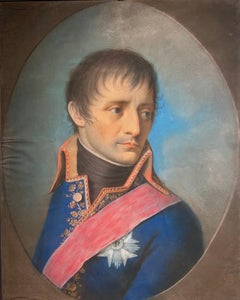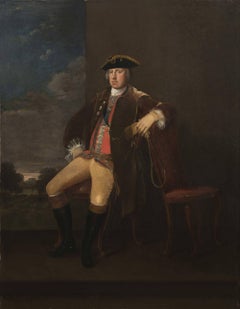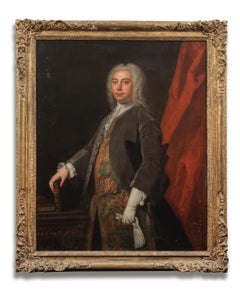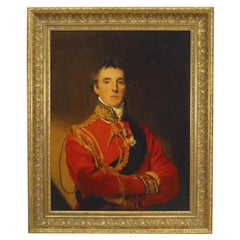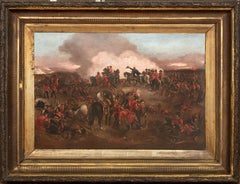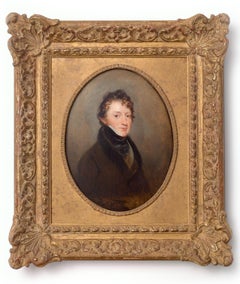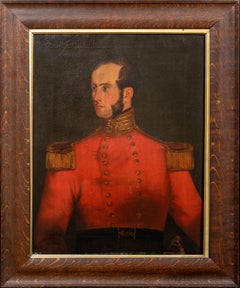Items Similar to Armand Emmanuel du Plessis, 5th Duke of Richelieu
Want more images or videos?
Request additional images or videos from the seller
1 of 2
19th Century English SchoolArmand Emmanuel du Plessis, 5th Duke of Richelieu
$12,762.49
£9,300
€10,934.85
CA$17,621.49
A$19,540.93
CHF 10,267.31
MX$238,756.90
NOK 128,458.02
SEK 120,579.80
DKK 81,630.79
About the Item
Oil on canvas
Image size: 10 x 7 1/2 inches (25.5 x 19 cm)
Contemporary gilt frame
This painting is a copy of Thomas Lawrence’s 1822 portrait of Armand Emmanuel du Plessis, Duke of Richelieu. As with the original portrait, this painting shows the Duke sporting the blue sash and medallion of the French Order of the Holy Spirit, the most prestigious chivalric order in France at the time. The viewer is just about able to make out the medallion’s dove symbol, and it is clear that the artist who copied the original portrait was dedicating his time to rendering the Duke’s face and hair. The grey curls, long nose and downturned mouth are diligent representations of Lawrence’s work, indicating the portraitist’s skill at rendering faces.
Armand Emmanuel du Plessis, Duke of Richelieu
The 5th Duke of Richelieu was born in Paris in 1766, and married Alexandrine Rosalie Sabine de Rochechouart-Faudoas at the age of fifteen. Shortly after the wedding, du Plessis embarked on a three-year Grand Tour of Italy. Upon his return, he joined Queen Marie Antoinette’s Regiment of Dragoons and joined the court of King Louis XVI, where he was in close contact with the monarch on a daily basis.
1789 is a notorious year in French history, and the du Plessis played a key role in saving the life of Marie Antoinette. Upon hearing of the March on Versailles, he disguised himself as part of the crowd and managed to reach the palace, heading straight to the Queen’s chambers and imploring her to shelter in the King’s quarters. He was then sent to Vienna to discuss the French Revolution with Marie Antoinette’s brother the Holy Roman Emperor Joseph II. Before du Plessis reached Vienna, Joseph II died and he was instead present for the coronation of the new emperor.
During this time, du Plessis rekindled his friendship with Austrian Prince Charles de Ligne and, accompanied by the Comte de Langeron, they joined the Imperial Russian Army. His service at the capture of Izmail earned him the Order of St George, the highest military decoration in Russia.
In 1791, du Plessis became the Duke of Richelieu upon the death of his father. He was summoned back to Paris but applied to be the French diplomat to Vienna. From here, du Plessis joined the counter-revolutionary Conde army. This military force suffered many defeats, but Catherine the Great offered military roles to Conde’s officers, an opportunity which du Plessis seized. He became a Major General under Catherine the Great, and was appointed as governor of Odessa under her grandson, Emperor Alexander I. Later, he became responsible for territories in Kerhson, Ekaterinoslav and Crimea, engaged in expeditions to the Caucasus, and commanded a unit in the 1806-1812 Russo-Turkish war. Under the care of du Plessis, Odessa became the third largest city in the Russian Empire - the people of Odessa erected a bronze monument of the Duke of Richelieu in 1828.
Du Plessis returned to France in 1814, but this was short lived as he soon returned to Vienna to rejoin the Russian Army and foster a relationship between the new King Louis XVIII and Alexander I. In 1815, he was appointed the Primer Minister of France, despite his royalist views, and held this position - as well as that of the Minister of Foreign Affairs - until the end of 1818. Du Plessis died of a stroke in 1822.
We would like to thank Adam Busiakiewicz for his help in identifying the sitter as the Duke of Richelieu.
- Creator:19th Century English School (English)
- Dimensions:Height: 10 in (25.4 cm)Width: 7.5 in (19.05 cm)
- More Editions & Sizes:10 x 7 1/2 inchesPrice: $12,762
- Medium:
- Movement & Style:
- Period:
- Condition:
- Gallery Location:London, GB
- Reference Number:1stDibs: LU52415815362
About the Seller
5.0
Vetted Professional Seller
Every seller passes strict standards for authenticity and reliability
Established in 2007
1stDibs seller since 2014
82 sales on 1stDibs
Typical response time: 3 hours
- ShippingRetrieving quote...Shipping from: London, United Kingdom
- Return Policy
Authenticity Guarantee
In the unlikely event there’s an issue with an item’s authenticity, contact us within 1 year for a full refund. DetailsMoney-Back Guarantee
If your item is not as described, is damaged in transit, or does not arrive, contact us within 7 days for a full refund. Details24-Hour Cancellation
You have a 24-hour grace period in which to reconsider your purchase, with no questions asked.Vetted Professional Sellers
Our world-class sellers must adhere to strict standards for service and quality, maintaining the integrity of our listings.Price-Match Guarantee
If you find that a seller listed the same item for a lower price elsewhere, we’ll match it.Trusted Global Delivery
Our best-in-class carrier network provides specialized shipping options worldwide, including custom delivery.More From This Seller
View AllPossible Portrait of Young Napoleon
Located in London, GB
Circle of Johann Heinrich Schmidt
Possible Portrait of Young Napoleon
1749-1829
Pastel on parchment
Image size: 23 1/2 x 19 inches
Unsigned
This portrait likely depicts a young Emp...
Category
Early 19th Century Portrait Paintings
Materials
Oil Pastel, Parchment Paper
Portrait of William Herbert, 3rd Earl of Pembroke, Early 17th Century Portrait
Located in London, GB
English School, (circa 1600)
Portrait of William Herbert, 3rd Earl of Pembroke
Oil on panel, oval
Image size: 29¼ x 23⅞ inches
Painted wooden frame
Provenance:
176, Collection of Francis Greville, 1st Earl of Warwick.
The Trustees of the Lord Brooks’ Settlement, (removed from Warwick Castle).
Sotheby’s, London, 22nd March 1968, lot 81.
Painted onto wooden panel, this portrait shows a dark haired gentleman in profile sporting an open white shirt. On top of this garments is a richly detailed black cloak, decorated with gold thread and lined with a sumptuous crimson lining. With the red silk inside it’s all very expensive and would fall under sumptuary laws – so this is a nobleman of high degree.
It’s melancholic air conforms to the contemporary popularity of this very human condition, evident in fashionable poetry and music of the period. In comparison to our own modern prejudices, melancholy was associated with creativity in this period.
This portrait appeared in the earliest described list of pictures of Warwick castle dating to 1762. Compiled by collector and antiquary Sir William Musgrave ‘taken from the information of Lord & Lady Warwick’ (Add. MSS, 5726 fol. 3) is described;
‘8. Earl of Essex – an original by Zuccharo – seen in profile with black hair. Holding a black robe across his breast with his right hand.’
As tempting as it is to imagine that this is a portrait of Robert Devereux, the 2nd Earl Essex, we might take this with a pinch of salt. Its identification with this romantic and fatal Elizabethan might well have been an attempt to add romance to Warwick Castle’s walls. It doesn’t correspond all that well with Essex’s portraits around 1600 after his return from Cadiz. Notably, this picture was presumably hung not too far away from the castle’s two portraits of Queen Elizabeth I. The first, and undoubtedly the best, being the exquisite coronation portrait that was sold by Lord Brooke in the late 1970s and now hangs in the National Portrait Gallery. The second, described as being ‘a copy from the original at Ld Hydes’, has yet to resurface.
The portrait eventually ended up being hung in the State Bedroom of Warwick Castle.
Archival documents present one other interesting candidate. The Greville family’s earliest inventory of paintings, made in 1630 at their home Brooke House in Holborn, London, describes five portraits of identified figures. All five belonged to the courtier, politician and poet Sir Fulke Greville (1554-1628), 1st Baron Brooke, and were hung in the ‘Gallerie’ of Brooke House behind yellow curtains. One of them was described as being of ‘Lord of Pembrooke’, which is likely to have been William Herbert (1580-1630), 3rd Earl of Pembroke. William was the eldest son of Greville’s best friend’s sister Mary Sidney, and was brought up in the particularly literary and poetically orientated household which his mother had supported. Notably, the 3rd Earl was one of the figures that Shakespeare’s first folio was dedicated to in 1623.
The melancholic air to the portrait corresponds to William’s own pretensions as a learned and poetic figure. The richness of the robe in the painting, sporting golden thread and a spotted black fabric, is indicative of wealth beyond that of a simple poet or actor. The portrait’s dating to around the year 1600 might have coincided with William’s father death and his own rise to the Pembroke Earldom. This period of his life too was imbued with personal sadness, as an illicit affair with a Mary Fitton had resulted in a pregnancy and eventual banishment by Elizabeth I to Wilton after a short spell in Fleet Prison. His illegitimate son died shortly after being born. Despite being a close follower of the Earl of Essex, William had side-stepped supporting Devereux in the fatal uprising against the Queen and eventually regained favour at the court of the next monarch James I.
His linen shirt is edged with a delicate border of lace and his black cloak is lined on the inside with sumptuous scarlet and richly decorated on the outside with gold braid and a pattern of embroidered black spots.
Despite the richness of his clothes, William Herbert has been presented in a dishevelled state of semi-undress, his shirt unlaced far down his chest with the ties lying limply over his hand, indicating that he is in a state of distracted detachment. It has been suggested that the fashion for melancholy was rooted in an increase in self-consciousness and introspective reflection during the late 16th and early 17th centuries.
In contemporary literature melancholy was said to be caused by a plenitude of the melancholy humor, one of the four vital humors, which were thought to regulate the functions of the body. An abundance of the melancholia humor was associated with a heightened creativity and intellectual ability and hence melancholy was linked to the notion of genius, as reflected in the work of the Oxford scholar Robert Burton, who in his work ‘The Anatomy of Melancholy’, described the Malcontent as ‘of all others [the]… most witty, [who] causeth many times divine ravishment, and a kind of enthusiamus… which stirreth them up to be excellent Philosophers, Poets and Prophets.’ (R. Burton, The Anatomy of Melancholy, London, 1621 in R. Strong, ‘Elizabethan Malady: Melancholy in Elizabethan and Jacobean Portraits’, Apollo, LXXIX, 1964).
Melancholy was viewed as a highly fashionable affliction under Elizabeth I, and her successor James I, and a dejected demeanour was adopted by wealthy young men, often presenting themselves as scholars or despondent lovers, as reflected in the portraiture and literature from this period. Although the sitter in this portrait is, as yet, unidentified, it seems probable that he was a nobleman with literary or artistic ambitions, following in the same vain as such famous figures as the aristocratic poet and dramatist, Edward de Vere...
Category
Early 17th Century Old Masters Portrait Paintings
Materials
Oil, Wood Panel
Portrait of a King's Messenger, 18th Century English Artist, Original Frame
By Charles Philips
Located in London, GB
Charles Philips
1703 - 1747
Portrait of a King's Messenger
Oil on canvas
Image size: 35 ¾ x 28 inches
Original gilt frame
King's Messenger
The job of a King's Messenger was that of a diplomatic courier, hand-carrying important and secret documents around the world. Some say that the history of the sovereigns' messengers goes back to 1199, but the first known messenger was John Norman, who in 1485 earned 4d (1½ pence) per day for carrying the state papers of Richard III.
The silver greyhound on the messenger's badge dates back to Charles II. In 1660, during his exile at Breda, Netherlands, Charles II issued a declaration of amnesty to all those who had opposed him and his father. He used messengers to make his intentions known. In answer to the messenger's question "How will they know me?", Charles reached forward to a silver bowl on the table in front of him. This bowl, with four decorative greyhounds standing proud above the rim, was well known to all courtiers. Charles broke off a greyhound and gave it to the messenger as a guarantee that the message came from him. From that date, the King's Messenger always wore a silver greyhound around his neck.
Later, dating from George II or III, a badge with the Royal Arms in enamel, with the greyhound suspended beneath, was worn. A George III example of the King's Messenger Badge, pre 1800, sold for over £30,000 pounds some years ago.
The silver greyhounds were minted for each new reign, except the brief one of King Edward VIII. The sovereign's messengers were originally controlled by the Lord Chamberlain, being Messengers of the Great Chamber. When the Foreign Office was created in 1782, the messengers remained common to the three Secretaries of State.
Charles Philips was an English artist known for painting a number of portraits and conversation pieces for noble and Royal patrons in the mid-eighteenth century.
Philips was baptised in the combined parish of St Mildred, Poultry with St Mary...
Category
18th Century Portrait Paintings
Materials
Canvas, Oil
Portrait of Ralph William Grey
By Bartholomew Dandridge
Located in London, GB
Provenance
By descent through the sitter's family to
The Collection of R. W. Vivian-Neal of Poundisford Park, Somerset, from whom acquired by
With Lane Fine Art, UK, where purchased by the present owners in 1996
Literature
'Poundisford Park, Somerset' in Country Life, 22 December 1934, ill.
A.W. and C.M. Vivian-Neal, Poundisford Park, Somerset: A catalogue of pictures and furniture, Taunton 1939, cat. nos. 11 and 13
This is a three-quarter-length portrait of Ralph William Grey in a mole-coloured velvet coat and a long waistcoat of green satin, heavily embroidered in gold. Under his left right hand is a black chapeau bras. He has white doe-skin gauntlet gloves.
Son of William and Ann Grey of Backworth: born 19 December 1707. He married Mary the daughter of William Rawstorne of Newall in 1741 and died 5 November 1786. He was educated at Eaton and Trinity College, Oxford.
Within a year of his birth Mrs Grey died and, according to the Country Life article 'From that time forward all Mr Grey's faculties were concentrated on the well-being of his son. The possession of an heir gave zest to his efforts to build up the family fortune: he was successful in most of his ventures. Years later his interest in life was centred in the home of his daughter-in-law and grandchildren'.
Grey's right hand is depicted in the present portrait resting on Locke's Essays and the Country Life article also records that there are constant references to John Locke...
Category
Mid-18th Century English School Portrait Paintings
Materials
Oil
Portrait of William Henry Kerr, Earl of Ancram, 4th Marquess of Lothian
Located in London, GB
James Fellowes
Flourished 1719 - 1750
Portrait of William Henry Kerr, Earl of Ancram, 4th Marquess of Lothian
Oil on canvas, signed & dated 1747
Image size: 29 1/2 x 24 1/2 inches (75 x 62 cm)
Original gilt wood frame
William Henry Kerr was born a member of the Scottish peerage to William, third Marquess of Lothian, and his first wife Margaret, daughter of Sir Thomas Nicholson of Kemnay, first Baronet. William was styled Master Jedburgh until 1722, when his father was elevated to a Marquessate, after which he was referred to as Lord Jedburgh until 1735. Following his father’s military footsteps, on 20 June 1735 Ancram was commissioned as a cornet to the regiment (11th Dragoons) of his grand-uncle, Lord Mark Kerr. Ancram married Lady Caroline...
Category
1740s Old Masters Portrait Paintings
Materials
Oil
Portrait of a Young Duke, 19th Century French Chalk Drawing
Located in London, GB
Black chalk, white smudge and highlights, on paper
Image size: 10 3/4 x 5 3/4 inches (27.25 x 14.5 cm)
A half-length portrait of a young Duke wearing a long wig...
Category
19th Century Portrait Drawings and Watercolors
Materials
Chalk
You May Also Like
Duke of Wellington Portrait
Located in Queens, NY
Copy of a portrait painting titled "Duke of Wellington" showing him in red military uniform
Category
Late 20th Century American Federal Paintings
Materials
Paint
The Duke of Wellington At The Battle Of Waterloo, 19th Century English School
Located in Blackwater, GB
The Duke of Wellington At The Battle Of Waterloo, 19th Century
English School
Large 19th Century English School scene of The Duke of Wellington at The Battle Of Waterloo, oil on ca...
Category
19th Century Landscape Paintings
Materials
Canvas, Oil
Portrait of John Manners later 7th Duke of Rutland
By Margaret Sarah Carpenter
Located in Douglas, Isle of Man
Margaret Sarah Carpenter 1793-1872, was an English portrait painter. She was one of the foremost portrait painters in the 19th Century, she ex...
Category
1830s Portrait Paintings
Materials
Oil, Panel
Portrait Of A British Officer, early 19th Century - Napoleonic Wars Era
Located in Blackwater, GB
Portrait Of A British Officer, early 19th Century
Napoleonic wars Era
Early 19th Century Napoleonic Wars Era portrait of a British military officer, oil on canvas. Excellent quality and condition portrait of the officer in his red tunic...
Category
Early 19th Century Portrait Paintings
Materials
Canvas, Oil
$2,634 Sale Price
20% Off
Portrait of Colonel Charles-Louis-Prosper Marquis de Chérisey (1786-1837)
Located in Paris, IDF
After Louis-Stanislas MARIN-LAVIGNE (Paris, 1797 – Paris, 1860)
Portrait of Colonel Charles-Louis-Prosper Marquis de Chérisey (1786-1837)
in the uniform of commander of the 38th lin...
Category
Mid-19th Century French School Portrait Paintings
Materials
Oil
19th century portrait military officer 5th Royal Lancashire Militia, East Lancs
Located in York, GB
A fine 19th century oil on canvas portrait stated to be Captain Paul John Henry Butler, 5th Royal Lancashire Militia, half length, wearing breast star. Hou...
Category
19th Century Realist Portrait Paintings
Materials
Oil
More Ways To Browse
19th Century Italian Art
Revolutionary War Art
Imperial Portrait
Medallion Paintings
Austrian 19th Century Painting
19th Century Counter
Portrait Medallion
Russian Empire Painting
Caucasus Art
Holy Spirit
19th Military Painting
19th Century Military Paintings
Alexander King
King George Ii
Thomas Alexander
Revolutionary War Antique
Marie Versailles
Alexander Ii Russian
